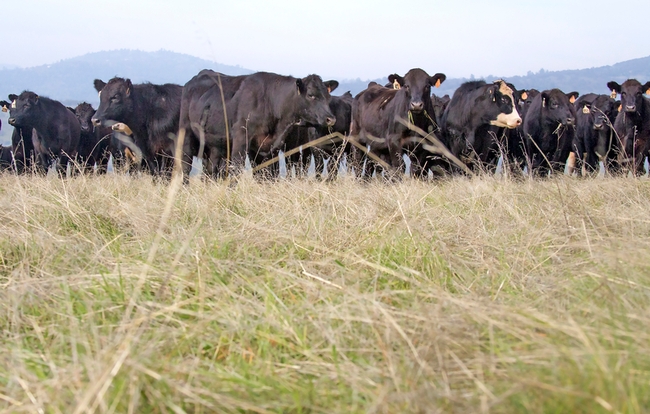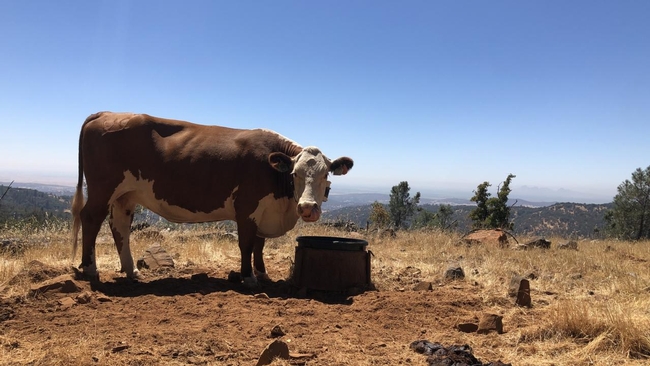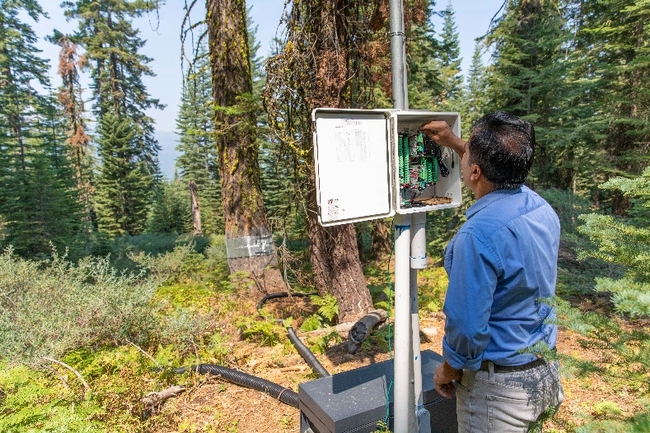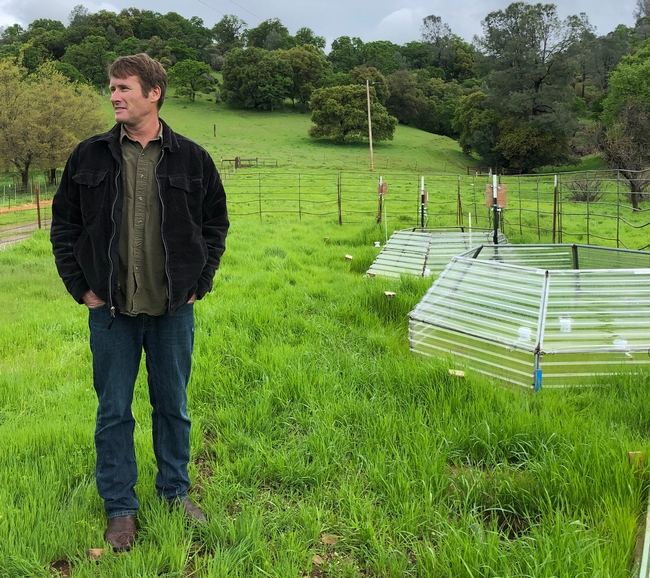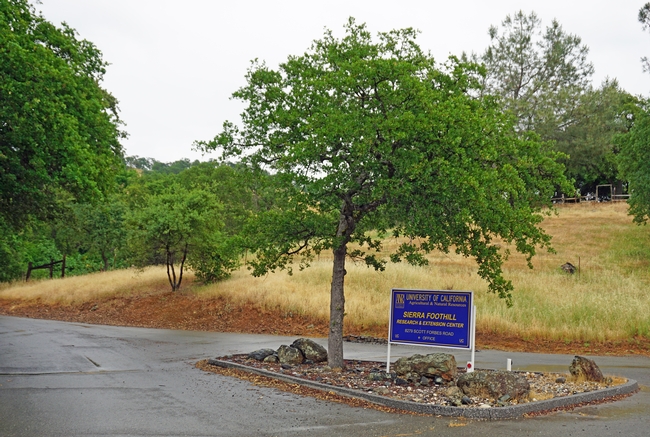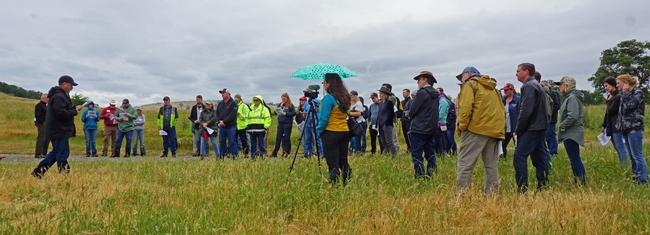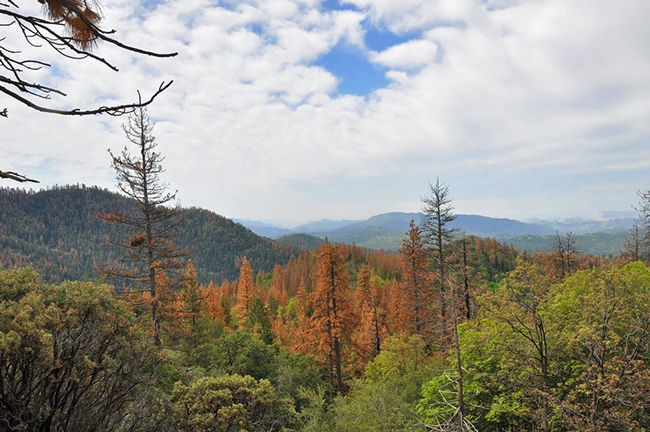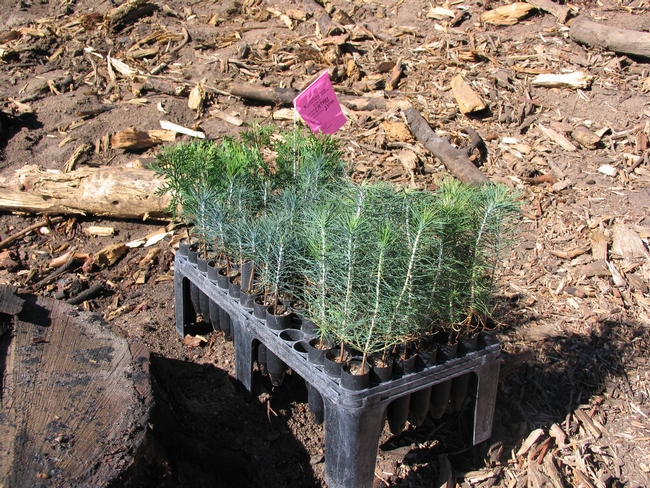
Posts Tagged: Sierra
Understanding cattle grazing personalities may foster sustainable rangelands
Matching herds to landscape can support animal growth and ecological needs
Not all cattle are the same when it comes to grazing. Some like to wander while others prefer to stay close to water and rest areas.
Recognizing those personality differences could help ranchers select herds that best meet grazing needs on rangelands, leading to better animal health and environmental conditions, according to a new paper from the University of California, Davis, published in the journal Applied Animal Behaviour Science.
“Cattle can actually be beneficial for the rangelands,” said lead author Maggie Creamer, who recently earned her Ph.D. in animal behavior at UC Davis. “Vegetation in rangelands actually need these kinds of disturbances like grazing.”
Ranchers can add elements to the rangeland such as water, mineral supplements and fencing to influence where cattle graze, but little research has been done on how those efforts affect individual cows. Considering personalities could save money.
“If you're spending all this money to add a management tool in order to change the distribution of your animals, that's a huge cost to ranchers,” said Creamer. “Thinking about other tools, or selecting certain animals with these grazing traits, might be a better way to optimize the distribution on rangeland rather than spending a bunch of money for something that may ultimately not pan out for all your animals.”
Effects of grazing
Livestock graze on an estimated 56 million acres in California, and healthy rangelands host native vegetation and animals, foster nutrient cycling and support carbon sequestration.
Uneven grazing can degrade water quality, soil health and habitats. Optimizing grazing — including the even spread of cow pies — can improve the ecosystem while also reducing fuel loads for wildfires.
To better understand individual grazing patterns, researchers went to the UC Sierra Foothill Research and Extension Center in Browns Valley and tracked 50 pregnant Angus and Hereford beef cows fitted with GPS collars.
The research
The cattle, which were tracked from June to August over two years, had access to 625 acres of grasslands and treed areas ranging in elevation from 600 to 2,028 feet. In the second year, a new watering site was added at a higher elevation.
Across the two years, the cows showed consistent and distinct grazing patterns even when water sources changed. Age and stage of pregnancy did not affect patterns, though cattle tended to clump near water and rest sites on hotter days.
The cows that ventured into higher elevations and farther from watering sites had more variability in their grazing patterns than those that stayed at lower elevations near water. That suggests it may be harder for non-wanderers to adjust to some landscapes.
“Thinking about the topography of your rangeland and your herd of cows can benefit both the animals and the sustainability of the land,” said Creamer, who next month begins work as a postdoctoral scholar in North Carolina.
Gauging personalities
Keying in on personality type may sound difficult, but the researchers also found some clues as to how to pinpoint the wanderers and homebodies. Unlike cattle at feedlots, the breeding cow population, especially on rangelands in California and other western states, live largely “wild” lives and are rarely handled, save for vaccinations and weaning.
Research due to be published later this year found that paying attention to individual cow reactions during those events can help determine personalities. The cows that appeared more passive during those handling interactions tended to be nomadic.
“We found that you can maybe predict those hill climbers if you kind of look at how they act when the veterinarian or rancher handle them,” said senior author Kristina Horback, an associate professor in the Department of Animal Science at UC Davis.
Informing practices
For ranchers, the findings could be invaluable, said Dan Macon, a livestock and natural resources Cooperative Extension advisor in Placer and Nevada counties for UC Agriculture and Natural Resources.
“Any time we can improve our understanding of cattle behavior, particularly at the individual level, it can improve how we handle livestock and manage the landscape,” he said.
Macon said that during the recent drought, it was hard to get cattle into higher country, but if ranchers could have selected the nomads, it may have saved money in terms of ranch labor and other efforts.
“If you ask a rancher who has been attentive to their cattle over many years, they know the personalities,” Macon said.
For Creamer and Horback, the research opens new doors into understanding herd behavior and dynamics, one that could be a cheaper alternative to high-tech solutions.
“Animal science tends to look overlook the mind of the animal when searching for solutions to challenges,” Horback said. “It's always been a direct line to genetics for immunity or nutrition, but nothing about the mind of the animal. And that's such a loss. There's so much we can learn from behavior in the end.”
The Russell L. Rustici Rangeland and Cattle Research Endowment supported the research.
This article was first published on the UC Davis News site.
French Meadows partnership completes fourth season of work
Safeeq Khan of UC ANR among collaborators on forest treatments in the Sierra
Despite the challenges of an extremely dangerous fire season, including California's largest wildfire in 2022 (Mosquito Fire) impeding access and limiting operations, partners of the French Meadows Forest Restoration Project have wrapped up their fourth season of forest treatments in the critical headwaters of Tahoe National Forest. Safeeq Khan, Cooperative Extension specialist in water and watershed sciences with UC Agriculture and Natural Resources, is among the collaborators.
This season, project partners safely treated over 700 acres of federal land using a combination of mastication, mechanical thinning, hand thinning and prescribed fire. On adjacent private land, the American River Conservancy independently raised funds and treated 338 acres. Combined, this all-lands collaborative watershed management project has treated over 6,000 acres in just four seasons.
Work this season focused on areas most prone to wildfire ignition. The United States Forest Service treated over 200 acres with prescribed pile burns in and around the Talbot campground, improving the aesthetic quality of this important recreation area just north of French Meadows Reservoir. Although dry conditions limited the scope of prescribed burns this year, using fire as a management tool is a cost-effective way to maintain forest conditions that contribute to ecosystem resilience and human health and safety.
“Prescribed burns are a critical component of the partnership's ecological forestry model,” explained Edward Smith, forest ecologist and fuels manager with The Nature Conservancy. “Under ‘prescribed conditions' of wind, moisture and temperature, broadcast burning helps reduce the amount of tinder on the forest floor as well as fuel ladders that could otherwise carry wildfires into the tops of trees, protecting habitat for humans and diverse wildlife species. Fire also reduces brush and twigs to ashes that feeds the roots of trees and understory plants, protecting the soil and its microbial universe, making them more resilient to drought, insects and climate change.”
Mechanical thinning, hand thinning, and mastication operations continued in areas surrounding water research instrumentation, installed by the Sierra Nevada Research Institute at the University of California, Merced. Over the coming years, researchers will be assessing how vegetation changes in ecologically-based forest management affect water quantity in the local watershed.
“Optimal restoration of forested headwaters benefits from dedicated partnerships collecting scientific data,” said Khan, who is also an adjunct professor of civil and environmental engineering at UC Merced. “UC Merced is working to provide this dimension at French Meadows with strategic measurements and modeling.”
Perhaps the partnership's biggest success in 2022 was securing, via multiple grants, the remaining funding necessary to complete all the thinning operations defined in the original project plan. Since the project's inception more than six years ago, the partnership has operated under an innovative funding arrangement consisting of local, state and federal dollars combined with private donations.
“What has impressed me most about the French Meadows partnership is its commitment to see the project all the way through: start to finish,” said Tahoe National Forest Supervisor Eli Ilano. “With the new funding secured this year, we will be able to wrap up thinning operations, and turn our focus to managing and maintaining the land for the enjoyment of the public.”
American River District Ranger Mary Grim with the U.S. Forest Service added, “This partnership learns from each year to adaptively manage for resilient forests that benefit everyone. The French Meadows Project is a reminder of what can be accomplished with a shared sense of stewardship for our forests and natural resources.”
Fuels reduction work this season resulted in more than 1.066 million board feet of overstocked timber, which was brought to a local mill, with the revenue generated offsetting some of the restoration costs. Project partners also repaired over seven miles of roadway and culverts to reduce sedimentation.
“Under the threat of a second consecutive severe fire season, including the Mosquito Fire in our own ‘backyard,' the partnership diligently moved treatment activities forward and began discussions on how to sustain the project's benefits through long-term maintenance planning,” said Kerri Timmer, regional forest health coordinator with Placer County, who coordinates the stewardship agreement with the Tahoe National Forest.
The catalyst of the French Meadows Forest Restoration Project was the 2014 King Fire, which burned over 97,000 acres in the American River watershed, much of it at high intensity. Eager to reduce the risk to hydroelectric assets, water quality, and biodiversity from future high severity wildfires, Placer County Water Agency joined with Placer County, The Nature Conservancy, the United States Forest Service, American River Conservancy, Sierra Nevada Conservancy, and the Sierra Nevada Research Institute at the UC Merced, to form the French Meadows Partnership.
The project spans more than 22,000 acres of federal land, nearly 7,000 acres of private land, and is a test case for the partnership's effectiveness in improving fire resilience and the overall health of the watershed.
To learn more about the French Meadows Forest Restoration Project, visit and tour the Project's story map.
UC ANR research to determine future climate change impacts today
Scientific evidence of a warming climate in California and across the globe is clear, but the impacts on ecosystems and agriculture are still difficult to predict.
Sophisticated computer models are used to forecast future climate. Understanding that temperature and precipitation levels will change in the future does not tell the full story: UC Agriculture and Natural Resources researchers also want real-world experience under those future conditions.
Moreover, some agricultural operations have higher sensitivity to the changes than others. Rangeland forage is particularly sensitive to climate changes since, unlike irrigated agriculture, ranchers rely solely on precipitation. They have no control over how much and when it rains.
“It's tricky business,” said rangeland expert Jeremy James, the director of the UC Sierra Foothill Research and Extension Center in Browns Valley. “It's not easy to forecast. We have to address the uncertainty in a realistic manner.”
Discovering climate change impact on rangeland
In order to study different climate projections on rangeland, James and Maggi Kelly, director of the UC ANR Informatics and Global Information Systems special program, have begun development of a research site that will allow scientists to manipulate the temperature and rainfall on sections of rangeland to understand what would happen under predicted weather scenarios.
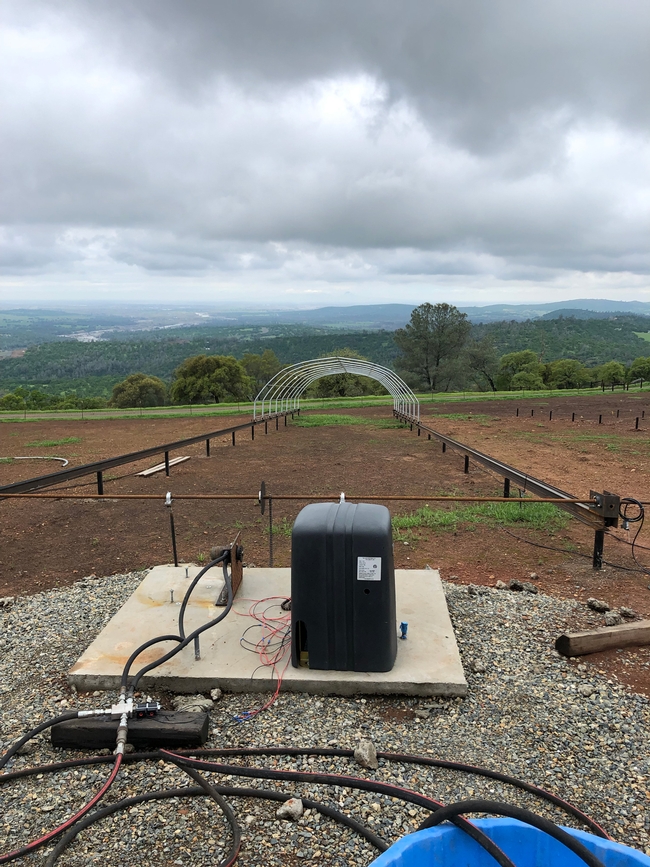
“We need to know how rangelands will respond when conditions change,” James said. “Will we grow more, but dry out earlier? Will we have more medusahead (an undesirable rangeland weed) or more soft chess (a high quality forage)?”
When complete, 16 shelters on steel tracks will be connected to computer systems and hydraulic motors to move them up or down a research plot. The shelters and other equipment will allow scientists to precisely control the amount of precipitation (or irrigation water) that rains onto the plot. Other systems will give researchers control of air temperature.
“This facility isn't designed for one type of research,” James said. “It is designed to conduct a wide variety of research by scientists over the next several decades. With this setup, we can look at the effect of climate change on soil biological communities, soil carbon, insect communities, plant-insect interactions and oak seedling recruitment.”
The research results from the project should provide ranchers and land managers a better understanding of how climate change may impact agriculture and ecosystem function on rangeland while also providing important information on how to minimize impacts of these changes.
Some aspects of the research facility's development are not covered with funding from the National Science Foundation. The scientists are looking for additional support to complete the project.
For more information, contact James at jjjames@ucanr.edu.
Current work underway at the Sierra Foothill Research and Extension Center
The Sierra Foothill REC, a 5,000-acre facility on the Yuba River, has supported research, education and outreach in the Sierra foothills since 1960. Multiple lines of research are being conducted at SFREC. During a recent workshop, scientists from UC Davis, UC Berkeley and UC Cooperative Extension shared a sampling of their work at SFREC.
UCCE livestock and natural resources advisor Dan Macon described a project aimed at helping ranchers make decisions about maintaining a cattle herd when faced with impending drought. Ranchers are reluctant to sell off their cattle even when the near future weather forecast is dire.
“Science tells us you shouldn't feed your way out of a drought,” Macon said. “But you want everything to stay the same. You want to maintain your genetic potential and keep cows that are familiar with the area.”
Working with ranchers, the research project will compare management practices to determine the best way forward when the future looks meteorologically bleak.
“We're assigning cows to a traditional weaning and early weaning groups,” Macon said. “They'll be out on the range from March to early September under different parameters. We're also tying in economics, the value of genetic potential and the value of having cows who know the landscape.”
Research by University of Oregon post doctorate researcher Ashley Shaw is looking into whether compost applied to rangeland will help mitigate climate change by sequestering more carbon, and also benefit forage under drought by increasing the soil's water-holding capacity and improving nutrient delivery.
Preliminary results are promising. A single application of 1/4-inch of compost resulted in forage production that was higher than areas where no amendment was applied and areas that were treated with a chemical fertilizer.
“The biggest impact was under drought shelters,” said Shaw, referring to PVC frames that were covered with plastic during rain events to understand the impact of the treatment under dry conditions. “In the drought plots, the areas where compost was applied are staying green longer.”
A defining research tool at SFREC is a dataset that includes information on monthly rainfall and forage production going back 40 years.
A review of the data shows surprising variations and correlations at the center, where forage production averages 3,000 pounds per acre, but ranges from about 1,000 pounds per acre in 1987, to over 5,000 pounds per acre in 2018, when there was so much growth, “we didn't have enough animals to graze,” James said.
The dataset paints a spectrum of the variation that ranchers across the state must navigate to manage their livestock and rangeland in a way that is profitable and ecologically sound. Research at the Sierra Foothill REC offers invaluable information to help them better understand the ecosystem and make informed decisions.
Art Shapiro: Worst Monarch Season Ever, But Best MIlkweed Season Ever
This year ranks as the worst monarch season he's ever seen in California. But...this year ranks as the best milkweed season he's ever seen in California. Butterfly guru Art Shapiro, distinguished professor of evolution and ecology at the University of California, Davis, has monitored...

A female monarch butterfly nectaring in a Vacaville pollinator garden. (Photo by Kathy Keatley Garvey)
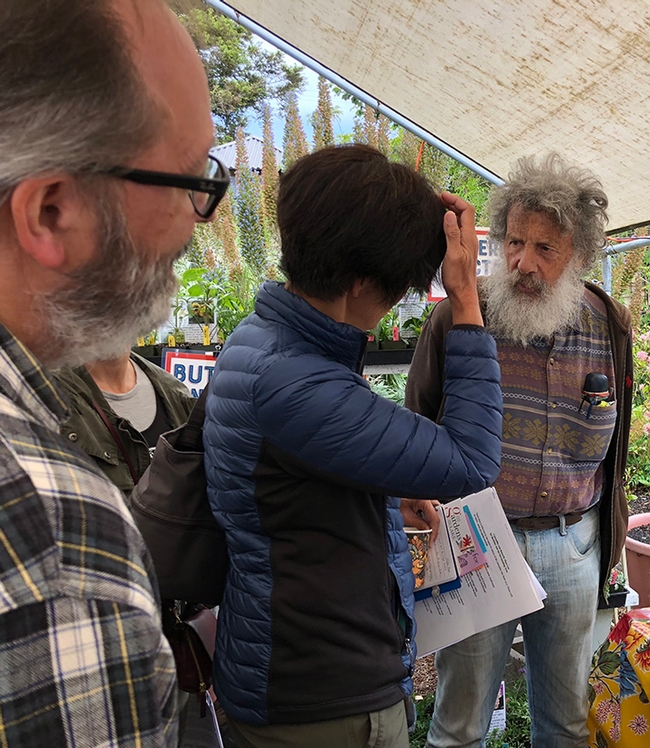
Art Shapiro, UC Davis distinguished professor of evolution and ecology, fields questions at the May 26 Butterfly Summit, held at Annie's Annuals and Perennials, Richmond. (Photo by Kathy Keatley Garvey)
Reevaluate the Sierra Nevada landscape after removing dead trees
This winter, a generous amount of rain and snow has fallen on California, but it can't erase the brown swaths of dead and dying trees in the Sierra Nevada caused by five years of drought and decades of forest mismanagement.
Fire suppression and the harvest of the largest and most resilient trees in the forest led to a large population of weak trees. The prolonged drought further weakened the trees' defenses against native insects. Aerial detection surveys show that more than 102 million trees have died since 2010; more than 62 million died in 2016 alone. Public and private landowners are now struggling to recover from this natural disaster.
UC Cooperative Extension forester and natural resources advisor Susie Kocher recommends dead trees be removed and the landscape reevaluated.
“The dead trees will eventually fall,” Kocher said. “Removing trees around homes and other buildings is especially important for safety. Also, when they fall on the ground they become large fuels on the forest floor, leading to more intense fires.”
The cost of removing the trees can be substantial. The State of California is funneling disaster relief funds through California counties, utilities are felling trees that pose a threat to power lines, and local jurisdictions are removing trees that could fall on roads and other public infrastructure. However, most tree removal is the responsibility of private landowners.
When the dead trees are gone, before considering replanting, Kocher suggests Sierra residents carefully assess what has survived.
“There is often a lot of live vegetation remaining,” Kocher said. “Make a map and mark where you find living trees and shrubs and identify them by species and size. If you have a significant number of trees left, you may not need to replant.”
Kocher suggests nurturing the remaining young trees.
“You may want to thin trees out so that available sun and soil moisture are focused on the healthiest individuals. Some watering in the summer may help counter stress caused by increased solar radiation,” she said.
If removing the dead trees leaves the landscape too bare, replanting native conifers is a good strategy. Conifers include pine, cedar and fir trees, but in California's dense forests, firs and cedars – which do well in shady conditions – are beginning to dominate. Replanting may be a time to give native pines – such as Jeffrey, ponderosa and sugar pines – a chance to recover ground.
“The fact that many pines have died does not necessarily mean they are no longer adapted to your location, even with our warming climate,” Kocher said. “There may be a few locations that are less suitable for trees that have grown there in the past, but for most areas, local growing conditions should support native conifers in the near future.”
Native plants and shrubs that died during the drought or were damaged during tree removal will likely come back on their own without replanting. Shrubs and oaks can re-sprout and native herbaceous plants generally store seed in the soil that will grow under native rainfall conditions.
Replanting of trees also gives landowners the chance to shape the landscape for best effect. Kocher offers the following recommendations on replanting trees in natural landscapes:
- Space trees at least 10 feet apart.
- Trees and flammable vegetation should be kept at least 10 feet away from the home, planted sparsely within 30 feet of the home and spaced widely enough in the 30 to 100-food zone so the crowns of the trees will not touch when they are mature. Beyond 100 feet, trees can fill into a more natural looking forest.
- Plant trees at least 10 feet from power lines.
- Do not plant trees within the road right of way to prevent interference with snow clearance, maintenance and construction projects.
- Plant pines where there is a lot of sun. Do not plant sugar pine on the driest sites.
- Avoid planting where the mature trees will block desired views.

